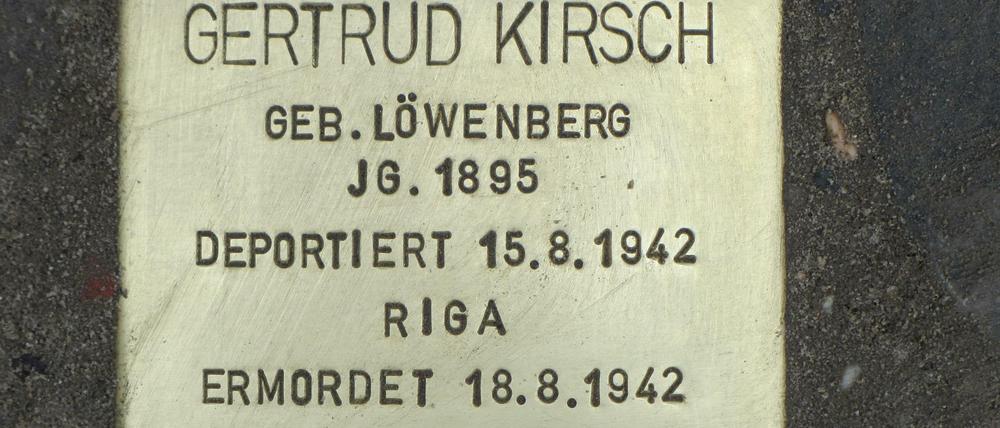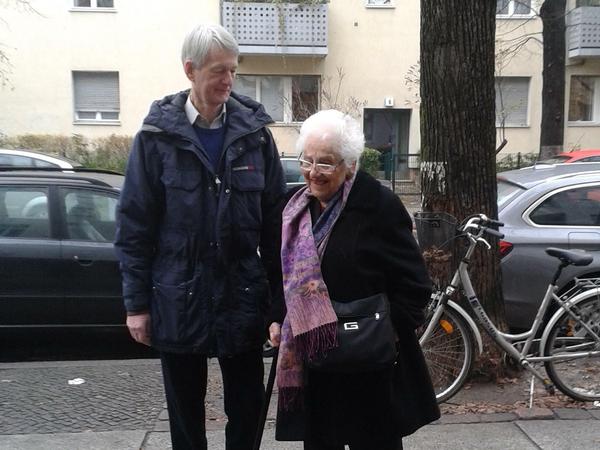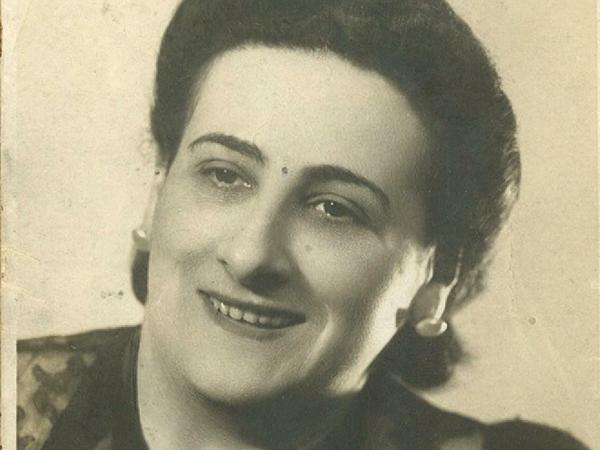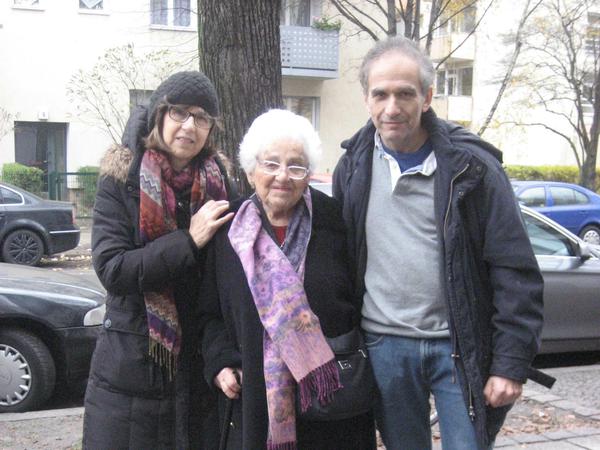
© F. Siebold/berlin.de
Holocaust Remembrance: One Small Act Of Defiance
Helga Lemer fled Nazi Germany in 1939. Aged 94, she returned to Berlin last weekend to visit the "Stolperstein" memorial stone dedicated to her mother, laid earlier this year in Wilmersdorf. Josie Le Blond traces her remarkable story.
On a bleak Totensonntag morning in Berlin, three figures brave the drizzle on a Wilmersdorf pavement. Their pilgrimage has led them across Europe to the brass plate at their feet; the only lasting memorial to the street's former resident, Gertrud Kirsch.
Ninety-four-year-old Helga Lemer gazes up at the second floor of the building at Güntzelstraße 62, where she lived with her mother in the late 1930s before fleeing Nazi Germany alone for Britain. Her mother Gertrud was not so fortunate. The Gestapo came for her in 1942.
"Why didn't she leave?" demands one neighbour from a small group of residents come to pay their respects to the foreign visitors. "She knew what was going to happen to her, why didn't she run away?"
Helga shakes her head. "She couldn't leave without the correct papers. My mother thought she had a way out, but the papers didn't come." With her words, a sombre mood settles on the locals as they observe a moment's silence.
Like thousands of German Jews before her, the Nazis deported Helga's mother Gertrud by train to Riga. After a three-day journey in squalid conditions, she was shot in the woods by an SS death squad and buried anonymously in a mass grave by her murderers.
For over 70 years, the name Gertrud Kirsch was marked only in Nazi officials' meticulously-noted registers of their deported victims. That is until this April, when her surviving family in London had a "Stolperstein" embedded outside Gertrud's final residence.
"Here lived Gertrud Kirsch, born Löwenberg, 1895," the ground-level plate reads. "Deported 15.8.1942, murdered 18.8.1942."
"I only heard about these Stolpersteine last year," says Gertrud's granddaughter Barbara Anders, who this weekend, together with her brother Robin, accompanied her elderly mother on the journey to see the memorial plaque in place.

© Josie Le Blond
"The Nazis tried to wipe out all trace of their victims," Helmut Lölhöffel, coordinator of the Wilmersdorf Stolpersteine project tells the gathered group of onlookers. The plaques, now found all over Europe, are a decentralised memorial designed to return the names of the Nazis' victims back to the place where they last lived, he says.
It has been 74 years. Yet stepping inside the building for a closer look, Helga immediately recognises the ornate hallway, the art deco lift, the balconies, the stained glass doors and the original stucco ceilings. Before long, her late teenage years spent living here come flooding back.
After her husband Felix died in 1937, Gertrud moved with Helga, then aged 16, into the pension on Güntzelstraße, a place popular with those who had sold their flats in preparation to emigrate from Germany. Standing in the reception room of the flat, which is still run as a pension today, Helga finds the entry "G. Kirsch, widow" on a framed list of former residents.
Growing up a Jew in Nazi Germany, Helga remembers the steady decline of her and her family's social standing after Adolf Hitler came to power in 1933. "I had a close non-Jewish friend who, once Hitler came to power, came to school and didn't speak to me anymore. When I asked her what the matter was she said her father was a Nazi," she says.
The daily morning ritual of obediently chanting “Heil Hitler” together with her classmates at the elite private school she attended took its toll on Helga. In May 1935 she asked to be transferred to a Jewish school. "I wanted to be altogether with the other Jews," she remembers.
The following year, enthusiastic sportswoman Helga celebrated a minor victory when she witnessed first hand the displeasure on Hitler's face when black American sprinter Jesse Owens won gold at the 1936 Olympic Games in Berlin.
"I went on a very interesting day when Jesse Owens won,” she says. “I was sitting opposite Hitler, who wouldn't shake hands with him. When the games were on they took all the notices down saying 'Jews not allowed.' The day after the Games finished everything went back up again."
"A person is only forgotten when their name is forgotten"

© Familienarchiv Lemer/Anders, London
As with many German Jews, the true menace behind the Nazis' intensifying persecution only dawned on Helga's family when her uncle was arrested during the Kristallnacht anti-Jewish pogrom on November 9, 1938.
After his release from a brief internment in a concentration camp, Helga's uncle was adamant the entire family should get out of Germany while they still could. "He said to my mother she had to send me away, that there was no life for me here," she remembers.
Within a few months, Gertrud had secured her daughter, then aged 18, papers and a passage on a ship to Britain. But she would have to go alone, with only a few suitcases and some petty cash to her name.
"It was terrible," says Helga. "My mother went alone to take me to Hamburg. We couldn't find anywhere to have lunch, the 'Jews not allowed' signs were everywhere." It was April 19th, 1939, the day before Hitler's 50th birthday. She never saw her mother again.
Gertrud did not leave Berlin, even as many close relatives fled to Shanghai, one of the few remaining destinations still at that time accepting German Jewish refugees without visas. "My uncle went with my grandmother to Shanghai. He wanted to take my mother with them but she said: 'Now there's a war on, Hitler won't have time for the Jews, he will be too busy,'" says Helga.
Living alone in London and working as a maid for a British family, Helga could guess little of her mother's impending fate. In the intervening years they exchanged heavily self-censored letters sent via a convoluted postal route, first through Belgium, later via America.
"My mother couldn't say much in the letters," says Helga. "She knew they would be opened and read. I found out from a friend's mother that my mother had been taken. But I didn't know any details until the war was finished."
On August 15, 1942 the Gestapo came to Güntzelstraße to arrest Gertrud, then aged 47, taking her first to be registered at an assembly point at a synagogue in Berlin Mitte. From there she was transferred to Bahnhof Moabit, where a train was waiting to take her and 1003 others to their final destination, Riga. On arrival, the records show Gertrud and the others were then led into a forest and shot by firing squad.

© Barbara Anders
"A person is only forgotten when their name is forgotten," Berlin artist and Stolperstein conceiver Gunter Demnig is often quoted as saying. 5000 of the tiny memorials have been laid on capital's streets since 1996, marking the last residences of some of the city's murdered Jews, homosexuals, Roma and Sinti along with the Nazis' political and religious opponents.
Helga and her family left Berlin that evening after a whistle-stop tour of the Jewish museum, Weißensee graves and the Holocaust memorial, hoping the new Stolperstein will cement the name of their murdered relative in the city she spent her whole life.
In decades to come the shiny brass plate on Güntzelstraße will still catch the eye of some curious passerby. Bending down to read the inscription, they will see the name Gertrud Kirsch, a small act of defiance against those who wished to wipe her and so many others off the face of the earth.
- Bayerisches Viertel
- Charlottenburg-Wilmersdorf
- Holocaust: Alle Beiträge zum Themenschwerpunkt
- In English
- Stolpersteine
- showPaywall:
- false
- isSubscriber:
- false
- isPaid:
- showPaywallPiano:
- false